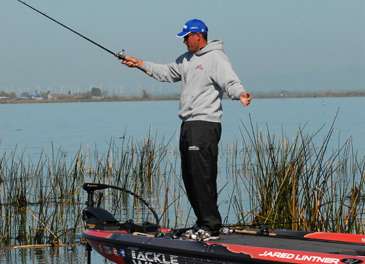
Clichéd is the notion that fishing has its ups and downs. However, that’s more than repetitious verbiage when speaking of tidal environments. In these atypical bass fisheries, the influence of a nearby ocean brings a daily rise and fall to the local inland waters, thereby creating a classic feast-or-famine scenario.
Finding the magical combination of structure and tide stage can yield jackpot potential, but the opportunity begins to die the moment it comes to life. Reason: The productive tidal scenario, whatever that happens to be, simply won’t last — at least not in one location.
Savvy anglers counter this limitation by “chasing the tide.” Strategically blending analysis and persistence, an angler determines a productive scenario, fishes a spot until the tide changes and then moves up or down the tidal zone to locate the same picture elsewhere. From the California Delta to Louisiana’s Atchafalaya Basin to the Potomac River, a mobile plan can keep you on the productive tide stage.
“You’re just covering ground, trying to keep up with moving water,” said Bassmaster Elite Series pro Jared Lintner of Arroyo Grande, Calif.
Local knowledge is always a plus, but armed with a daily tide chart (often distributed at bait shops, but always available online), anyone can figure out where they need to fish and when. Just know that a rising tide starts at the seaward end of a tidal fishery and advances to the upper end. The Outgoing cycle does the same in the opposite direction.
That means each moment of the tide’s rise and fall will replicate itself hundreds of times throughout a tidal fishery each day. Lintner, who frequently chases the California Delta tides, said not all tidal fisheries are created equally, so understanding the particular environment is critical to timing the water.
“The Delta is so big and vast the water takes a lot longer to get into different areas, so chasing the tide is tougher,” he said. “Whereas, on the Potomac the whole thing rises and falls together. There are a number of creeks and (backwaters), but for the most part, it’s more of a straight course.”
In any tidal environment, Lintner cautions anglers against getting sidetracked. Like the sirens of the sea luring Odysseus to a rocky fate, tidal triumphs can subtly destroy one’s otherwise viable plan.
“Maybe on your second spot, you catch one 8-pounder and then end up staying there all day when you should keep moving,” he said. “Instead of falling in love with a place, you have to know what you’re targeting and know when it’s time to go. If your plan is to run the tide, then stick with it, because otherwise, if you don’t time it right, you can miss the bite.
“When the fish want to feed on a fast-moving current, you may have a good slough, but you’ll only have about an hour when the fish will feed. You can waste a lot of time fishing the best (area) throughout the tide, whereas you can cover a lot of productive water during the peak periods by chasing the tide.”
Lintner also notes that tide chasers must remain versatile, as the right water stage may occur in different habitats along your route. “The tide positions the fish, so depending on where the current comes in, it may hit a rock jetty or maybe a tule berm or a log jam next to a flooded island. Those three things are very different, so you can’t fish the same baits. You’re looking for the places where the current is making those fish sit where they want to be, but you have to approach each one differently.”
On that point, Lintner selects his baits based on habitat. One spot may favor flipping, while cranking or spinnerbaits make more sense elsewhere. Incoming tides tend to clear up area waters, while falling tides are often the muddiest. Take note of local conditions and select the bait size and color that works best for the local conditions.
Lastly, make sure you carefully monitor water levels on falling tides. Shallow backwater areas may present irresistible opportunities, but stay too long and you’ll risk running out of water and being stuck when the tide departs.





